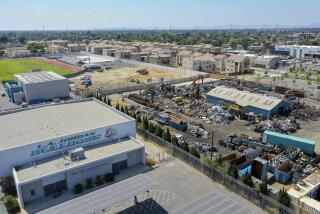Mix of cat litter, salts blamed for accident at nuclear waste storage site
- Share via
Reporting from Albuquerque — An incompatible combination of nitrate salts and organic cat litter is to blame for an accident that forced the closure of the nation’s only underground nuclear waste repository, according to findings released Thursday by an independent team of experts from national laboratories around the country.
The technical team was charged by the U.S. Energy Department to investigate all the possible scenarios that could have led to the release of radioactive material at the Waste Isolation Pilot Plant in Carlsbad, N.M., in February 2014.
The report came more than a year after a single container of waste stored at the repository breached and contaminated 21 workers with low-level radioactivity. That container had been packed at Los Alamos National Laboratory, also in New Mexico.
Though it couldn’t determine the cause of the breach with certainty, the team said it was clear a thermal reaction inside the container forced the lid to pop.
The contents — which included nitrate salt residues, the organic cat litter and a neutralizing agent — made for a “potentially reactive chemical mixture of fuels and oxidizers,” the team said. The way the materials were situated inside the drum also probably played a role, it added.
The salt residue comes from plutonium processing at the laboratory. The cat litter was used to absorb moisture in the waste.
“A series of ever-increasing heat releasing reactions occurred, which led to the creation of gases within the drum,” the team wrote in a 277-page report. “The resulting buildup of gases within the drum displaced the drum lid, venting radioactive material and hot matter that further reacted with the air or other materials outside the drum.”
The findings are in line with what experts theorized in the months after the incident. Los Alamos came under fire for not following protocols when it came to handling and packing the waste. A lab spokesman declined to comment on the new findings.
There are other containers that include similar mixtures of chemicals.
“We are reviewing the report and its findings now as we continue working to mitigate the risks of this happening again,” the Energy Department said in a statement issued Thursday. “Additional precautions have also been taken to secure other drums with similar nitrate and organic materials as those identified in the report.”
The agency reiterated what Energy Secretary Ernest J. Moniz told a Senate subcommittee this week: The Waste Isolation Pilot Plant is of critical importance to the agency as it works to clean up tons of Cold War-era waste from sites around the country.
A final accident investigation report into the incident is expected in the coming weeks, department officials said.
The technical team found that the radioactive contamination inside the underground repository came from the drum numbered 68660.
Using modeling, chemical analyses and other methods, the team considered the possibility that something outside the container caused it to breach, such as a reaction between water and magnesium or reduced ventilation that resulted after a fire at the nuclear dump. But the evidence pointed to the reaction happening inside the drum.
The team acknowledged its investigation was hampered by limited and inconsistent documentation regarding the way Los Alamos processed the waste and because access to the drum in question was limited because of safety concerns.
The Energy Department and the contractors that run the repository and Los Alamos lab are facing $54 million in fines from the state of New Mexico for the failures that led to the accident. Negotiations are ongoing.
More to Read
Sign up for Essential California
The most important California stories and recommendations in your inbox every morning.
You may occasionally receive promotional content from the Los Angeles Times.










